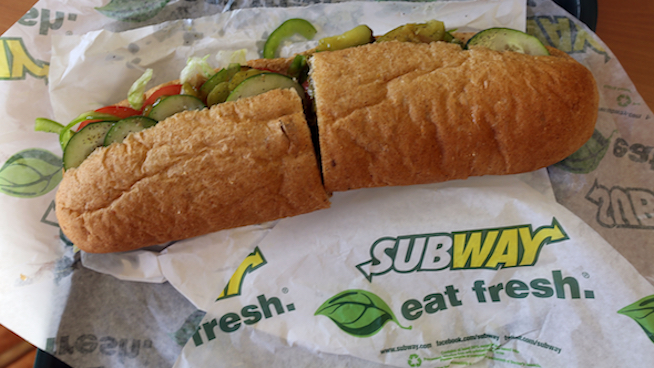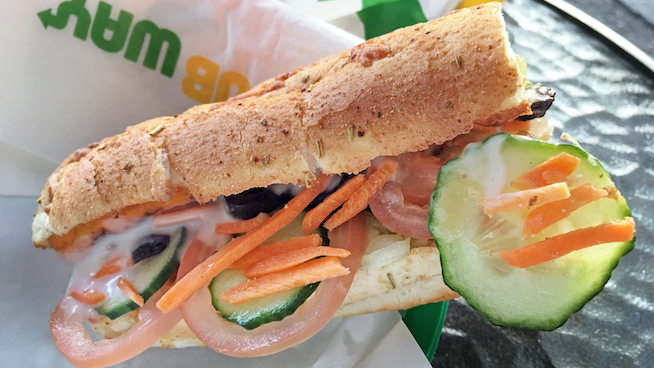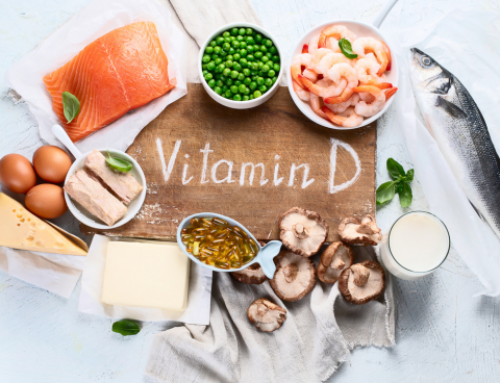Is Subway Actually Healthy?
Subway is the most popular restaurant chain in America.
As of June 2018, the sandwich chain boasted more than 25,800 locations in the U.S., dwarfing the size of Starbucks (14,300 restaurants) and McDonald’s (14,000 restaurants).
That means A LOT of people are eating at Subway. The chain’s explosive growth is due in large part to the healthy image they’ve cultivated. In many people’s minds, Subway is a markedly better option than a fast food burger joint.
But just how healthy is Subway, really? Is it actually helping Americans eat healthier, or is it a hidden culprit behind our sky-high obesity rates?
Subway offers a ton of options. To help keep the scope of this article focused, we’re going to focus largely on the chain’s namesake—sub sandwiches. When you go to Subway, you basically pick from five major categories to build your sandwich—meat, bread, cheese, veggies and condiments. Let’s look at these categories one by one before considering the nutrition of a full sandwich and reaching a final verdict.
Subway Bread
Some of the healthiest Subway bread options are the 9-grain wheat, the 9-grain honey oat, and the multigrain and artisan flatbreads. These are fairly low in calories, but more importantly, they’re fairly low in something that plagues the nutrition of many other Subway breads—sodium.
Consider this: A 6-inch Roasted Garlic roll packs 1,240mg of sodium. The 6-inch Spinach, Tomato Basil, and Habanero Wraps contain 780mg, 730mg, and 690mg of sodium, respectively. A 6-inch Parmesan Oregano roll contains 490mg, while a 6-inch Italian Herbs & Cheese contains 530mg. The footlong sizes obviously contain double these amounts. If you head to Subway for lunch and start your order with a footlong on Italian Herbs & Cheese, you’re up to 1,070mg of sodium before putting anything in your sandwich.
Although sodium is an essential nutrient—your body needs it to survive—it’s also incredibly easy to overindulge on the stuff. In fact, studies show that 9 in 10 Americans consume too much sodium. Over-consuming sodium can lead to high blood pressure, heart failure, stroke and a wide range of other issues. Health officials estimate that if Americans lowered their daily sodium intake to the recommended range, it would prevent up to 92,000 deaths annually. The recommended daily level of sodium intake is 1,500 mg—about the amount you’ll find in 2/3rds of a teaspoon of table salt. (Note: While many equate salt with sodium, sodium is in fact a component of salt. Table salt is about 40 percent sodium; the rest is chloride.) Although athletes who work out at a high intensity for several hours a day can get away with eating more, people who work out only moderately (for an hour or less per day) typically don’t sweat enough to warrant a high-sodium diet. According to estimates, the average American consumes 3,400 mg of sodium a day—more than twice the recommended value.
The worst bread is undoubtedly the Ultimate Cheesy Garlic Bread. A 6-inch roll packs an ungodly 480 calories, 12 grams of saturated fat and 790mg of sodium. That’s comparable to what you’d find in a McDonald’s Big Mac. Double those totals for a 12-inch roll and you’ve got yourself an absolute nutritional nightmare before you even include meat, cheese or sauce.
Subway Meats

Photo: Andrey Rudakov/Bloomberg
The meat is the main attraction of most Subway sandwiches. Quite honestly, the nutrition from meat to meat varies wildly.
The Chicken Strips (6-inch portion), for example, contain just 80 calories and 210 grams of sodium. But on the flip side, the Meatballs (6-inch portion) contain 260 calories and 720mg of sodium.
The Tuna (6-inch portion) seems like a solid choice at 250 calories and 300mg of sodium, but the Corned Beef (6-inch portion), with its 3 grams of saturated fat and 1,070mg of sodium, is quite the opposite.
The Turkey Breast (6-inch portion) is rather light at 50 calories, but the Italian B.M.T. Meats (6-inch portion) contains nearly four times the calories plus 990mg of sodium.
The BBQ Pulled Pork (6-inch portion) and Orchard Chicken Salad (6-inch portion) contain 18 and 8 grams of sugar, respectively.
Subway offers 30 different variation of “Individual Meats,” so you really have to look at each one’s nutrition to get a full picture of what you’re working with. But a general rule of thumb is that the more plain your meat is, the healthier it probably is—options like Turkey Breast, Tuna, Ham and Chicken Strips are healthy enough. But many of the Italian meat options and the meats soaked in sauce (BBQ Pulled Pork, Meatballs) have some serious issues.
Subway Cheese
Many people think cheese is unhealthy, but the cheeses at Subway aren’t going to bankrupt your sandwich on their own.
Most of the 6-inch portions hover around 50 calories and contain roughly 2 grams of saturated fat. Pepperjack, Monterey Cheddar and American are probably the worst overall options, due to their slightly higher amounts of saturated fat and/or sodium compared to the other options.
Subway Veggies
If you want to add valuable nutrients to your Subway sandwich, go big with the veggies. Every option is extremely low in calories but packed with vitamins, minerals and phytonutrients. Avocado, which is categorized by Subway as one of their veggies, is packed with healthy fats and vitamin C. By picking a colorful mix of vegetables to add to your sandwich, you ensure a diverse array of healthful nutrients.
Subway Condiments
Condiments are a great way to add flavor to any food. However, the wrong sauce can pack a surprising amount of bad stuff in a couple squirts.
A little bit of oil or vinegar? No problem. Mustard or light mayo? Sure. Guacamole? Right on.
But a lot of Subway’s most popular sauces have some serious issues. For example, the Sweet Onion and Sweet Chili sauces. Those contain a staggering 8 grams of sugar per 8-ounce serving. Creamy Italian contains 4 grams, Ketchup contains 5 grams, Honey Mustard contains 6 grams, and Barbecue Sauce contains 9 grams. And those figures are doubled for a footlong. That’s a ton of sugar!
Say you add Sweet Onion sauce to your footlong sandwich. You just added the sugar equivalent of more than five Starbursts to your meal. Worse yet, almost all the sugar found in these sauces is of the added sugar variety. Overconsumption of added sugar is arguably the biggest issue in the modern American diet.
The American Heart Association recommends that women consume less than 100 calories of added sugar per day (about 25 grams) and men less than 150 calories per day (about 36 grams). The average American overshoots those targets by a mile, consuming about 88 grams (equivalent to 22 teaspoons) per day. Diets high in added sugar have been linked to obesity, Type 2 diabetes, heart disease, tooth decay and even cancer. There’s also a growing amount of research connecting overconsumption of added sugar to an increased risk of depression.
Other condiments are quite high in sodium (the Buffalo Sauce packs 400mg per 6-inch serving), while some have troubling amounts of saturated fat (the Savory Caesar contains 2.5 grams per 6-inch serving).
Eating too much saturated fat drastically increases your risk of high cholesterol, which in turn can have a negative impact on blood flow and oxygen transportation throughout the body. The American Heart Association recommends that no more than 6% of your daily calories come from saturated fat. For a 2,000-calories-a-day diet, that translates to a limit of 13 grams of saturated fat each day.
Is Subway Actually Healthy?
It is absolutely, 100% possible to eat healthy at a Subway.
The Fresh Fit sandwiches are a selection of 8 six-inch subs which all come in under 400 calories, contain at least 2 servings of veggies, and pack 24 grams of whole grains. To meet these qualifications, the sandwich must be prepared on 9-grain wheat bread with tomatoes, onions, green peppers, cucumbers, lettuce, spinach and up to one Fresh Fit sauce.
But on the other hand, it’s very easy to have a meal at Subway that seems moderately healthy, but in reality is anything but. Say you order a foot-long Sweet Onion Chicken Teriyaki on Italian Herbs & Cheese bread. You get it with American cheese, banana peppers and lettuce. While the sandwich contains 880 calories, which isn’t terrible, it also packs a staggering 2,470mg of sodium, 29 grams of sugar, and 9 grams of saturated fat.
That’s child’s play compared to a foot-long Italian B.M.T. on Roasted Garlic bread with Pepperjack, though, which contains 4,740mg of sodium, 17 grams of saturated fat and 22 grams of sugar.
The biggest problem with Subway is that there are a ton of different sandwich components—be them bread, meats or condiments—that can sabotage the nutrition of your meal. When you combine several of these options together, you can get a junk food bomb that rivals the worst that McDonald’s, Taco Bell and the like have to offer. And this is to say nothing of the many cookies, chips, and sugar-sweetened beverages the chain also offers.
If you can stick to the Fresh Fit options or slight variations off of them, you can certainly eat healthy at Subway. But if you’re in doubt about the health of your Subway sandwich, odds are it’s not very healthy. If you’re a frequent Subway customer, your best course of action is to visit the chain’s official website, punch some of your favorite options into their nutrition calculator, and get the unfiltered nutrition numbers. Then at least you can make an informed choice the next time you find yourself in line at America’s most popular chain restaurant.
Photo Credit: chameleonseye/iStock, TennesseePhotographer/iStock, Ulrich Baumgarten/Getty Images, Andrey Rudakov/Getty Images, Joe Raedle/Getty Images
RECOMMENDED FOR YOU
MOST POPULAR
Is Subway Actually Healthy?
Subway is the most popular restaurant chain in America.
As of June 2018, the sandwich chain boasted more than 25,800 locations in the U.S., dwarfing the size of Starbucks (14,300 restaurants) and McDonald’s (14,000 restaurants).
That means A LOT of people are eating at Subway. The chain’s explosive growth is due in large part to the healthy image they’ve cultivated. In many people’s minds, Subway is a markedly better option than a fast food burger joint.
But just how healthy is Subway, really? Is it actually helping Americans eat healthier, or is it a hidden culprit behind our sky-high obesity rates?
Subway offers a ton of options. To help keep the scope of this article focused, we’re going to focus largely on the chain’s namesake—sub sandwiches. When you go to Subway, you basically pick from five major categories to build your sandwich—meat, bread, cheese, veggies and condiments. Let’s look at these categories one by one before considering the nutrition of a full sandwich and reaching a final verdict.
Subway Bread
Some of the healthiest Subway bread options are the 9-grain wheat, the 9-grain honey oat, and the multigrain and artisan flatbreads. These are fairly low in calories, but more importantly, they’re fairly low in something that plagues the nutrition of many other Subway breads—sodium.
Consider this: A 6-inch Roasted Garlic roll packs 1,240mg of sodium. The 6-inch Spinach, Tomato Basil, and Habanero Wraps contain 780mg, 730mg, and 690mg of sodium, respectively. A 6-inch Parmesan Oregano roll contains 490mg, while a 6-inch Italian Herbs & Cheese contains 530mg. The footlong sizes obviously contain double these amounts. If you head to Subway for lunch and start your order with a footlong on Italian Herbs & Cheese, you’re up to 1,070mg of sodium before putting anything in your sandwich.
Although sodium is an essential nutrient—your body needs it to survive—it’s also incredibly easy to overindulge on the stuff. In fact, studies show that 9 in 10 Americans consume too much sodium. Over-consuming sodium can lead to high blood pressure, heart failure, stroke and a wide range of other issues. Health officials estimate that if Americans lowered their daily sodium intake to the recommended range, it would prevent up to 92,000 deaths annually. The recommended daily level of sodium intake is 1,500 mg—about the amount you’ll find in 2/3rds of a teaspoon of table salt. (Note: While many equate salt with sodium, sodium is in fact a component of salt. Table salt is about 40 percent sodium; the rest is chloride.) Although athletes who work out at a high intensity for several hours a day can get away with eating more, people who work out only moderately (for an hour or less per day) typically don’t sweat enough to warrant a high-sodium diet. According to estimates, the average American consumes 3,400 mg of sodium a day—more than twice the recommended value.
The worst bread is undoubtedly the Ultimate Cheesy Garlic Bread. A 6-inch roll packs an ungodly 480 calories, 12 grams of saturated fat and 790mg of sodium. That’s comparable to what you’d find in a McDonald’s Big Mac. Double those totals for a 12-inch roll and you’ve got yourself an absolute nutritional nightmare before you even include meat, cheese or sauce.
Subway Meats

Photo: Andrey Rudakov/Bloomberg
The meat is the main attraction of most Subway sandwiches. Quite honestly, the nutrition from meat to meat varies wildly.
The Chicken Strips (6-inch portion), for example, contain just 80 calories and 210 grams of sodium. But on the flip side, the Meatballs (6-inch portion) contain 260 calories and 720mg of sodium.
The Tuna (6-inch portion) seems like a solid choice at 250 calories and 300mg of sodium, but the Corned Beef (6-inch portion), with its 3 grams of saturated fat and 1,070mg of sodium, is quite the opposite.
The Turkey Breast (6-inch portion) is rather light at 50 calories, but the Italian B.M.T. Meats (6-inch portion) contains nearly four times the calories plus 990mg of sodium.
The BBQ Pulled Pork (6-inch portion) and Orchard Chicken Salad (6-inch portion) contain 18 and 8 grams of sugar, respectively.
Subway offers 30 different variation of “Individual Meats,” so you really have to look at each one’s nutrition to get a full picture of what you’re working with. But a general rule of thumb is that the more plain your meat is, the healthier it probably is—options like Turkey Breast, Tuna, Ham and Chicken Strips are healthy enough. But many of the Italian meat options and the meats soaked in sauce (BBQ Pulled Pork, Meatballs) have some serious issues.
Subway Cheese
Many people think cheese is unhealthy, but the cheeses at Subway aren’t going to bankrupt your sandwich on their own.
Most of the 6-inch portions hover around 50 calories and contain roughly 2 grams of saturated fat. Pepperjack, Monterey Cheddar and American are probably the worst overall options, due to their slightly higher amounts of saturated fat and/or sodium compared to the other options.
Subway Veggies
If you want to add valuable nutrients to your Subway sandwich, go big with the veggies. Every option is extremely low in calories but packed with vitamins, minerals and phytonutrients. Avocado, which is categorized by Subway as one of their veggies, is packed with healthy fats and vitamin C. By picking a colorful mix of vegetables to add to your sandwich, you ensure a diverse array of healthful nutrients.
Subway Condiments
Condiments are a great way to add flavor to any food. However, the wrong sauce can pack a surprising amount of bad stuff in a couple squirts.
A little bit of oil or vinegar? No problem. Mustard or light mayo? Sure. Guacamole? Right on.
But a lot of Subway’s most popular sauces have some serious issues. For example, the Sweet Onion and Sweet Chili sauces. Those contain a staggering 8 grams of sugar per 8-ounce serving. Creamy Italian contains 4 grams, Ketchup contains 5 grams, Honey Mustard contains 6 grams, and Barbecue Sauce contains 9 grams. And those figures are doubled for a footlong. That’s a ton of sugar!
Say you add Sweet Onion sauce to your footlong sandwich. You just added the sugar equivalent of more than five Starbursts to your meal. Worse yet, almost all the sugar found in these sauces is of the added sugar variety. Overconsumption of added sugar is arguably the biggest issue in the modern American diet.
The American Heart Association recommends that women consume less than 100 calories of added sugar per day (about 25 grams) and men less than 150 calories per day (about 36 grams). The average American overshoots those targets by a mile, consuming about 88 grams (equivalent to 22 teaspoons) per day. Diets high in added sugar have been linked to obesity, Type 2 diabetes, heart disease, tooth decay and even cancer. There’s also a growing amount of research connecting overconsumption of added sugar to an increased risk of depression.
Other condiments are quite high in sodium (the Buffalo Sauce packs 400mg per 6-inch serving), while some have troubling amounts of saturated fat (the Savory Caesar contains 2.5 grams per 6-inch serving).
Eating too much saturated fat drastically increases your risk of high cholesterol, which in turn can have a negative impact on blood flow and oxygen transportation throughout the body. The American Heart Association recommends that no more than 6% of your daily calories come from saturated fat. For a 2,000-calories-a-day diet, that translates to a limit of 13 grams of saturated fat each day.
Is Subway Actually Healthy?
It is absolutely, 100% possible to eat healthy at a Subway.
The Fresh Fit sandwiches are a selection of 8 six-inch subs which all come in under 400 calories, contain at least 2 servings of veggies, and pack 24 grams of whole grains. To meet these qualifications, the sandwich must be prepared on 9-grain wheat bread with tomatoes, onions, green peppers, cucumbers, lettuce, spinach and up to one Fresh Fit sauce.
But on the other hand, it’s very easy to have a meal at Subway that seems moderately healthy, but in reality is anything but. Say you order a foot-long Sweet Onion Chicken Teriyaki on Italian Herbs & Cheese bread. You get it with American cheese, banana peppers and lettuce. While the sandwich contains 880 calories, which isn’t terrible, it also packs a staggering 2,470mg of sodium, 29 grams of sugar, and 9 grams of saturated fat.
That’s child’s play compared to a foot-long Italian B.M.T. on Roasted Garlic bread with Pepperjack, though, which contains 4,740mg of sodium, 17 grams of saturated fat and 22 grams of sugar.
The biggest problem with Subway is that there are a ton of different sandwich components—be them bread, meats or condiments—that can sabotage the nutrition of your meal. When you combine several of these options together, you can get a junk food bomb that rivals the worst that McDonald’s, Taco Bell and the like have to offer. And this is to say nothing of the many cookies, chips, and sugar-sweetened beverages the chain also offers.
If you can stick to the Fresh Fit options or slight variations off of them, you can certainly eat healthy at Subway. But if you’re in doubt about the health of your Subway sandwich, odds are it’s not very healthy. If you’re a frequent Subway customer, your best course of action is to visit the chain’s official website, punch some of your favorite options into their nutrition calculator, and get the unfiltered nutrition numbers. Then at least you can make an informed choice the next time you find yourself in line at America’s most popular chain restaurant.
Photo Credit: chameleonseye/iStock, TennesseePhotographer/iStock, Ulrich Baumgarten/Getty Images, Andrey Rudakov/Getty Images, Joe Raedle/Getty Images















